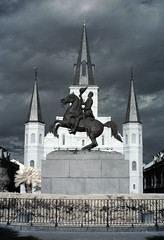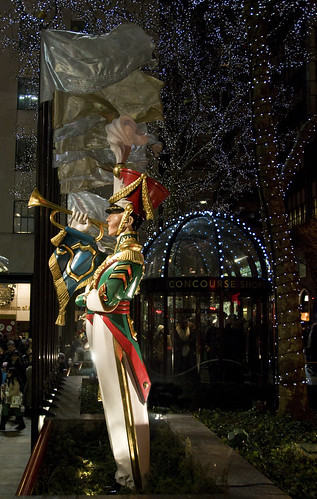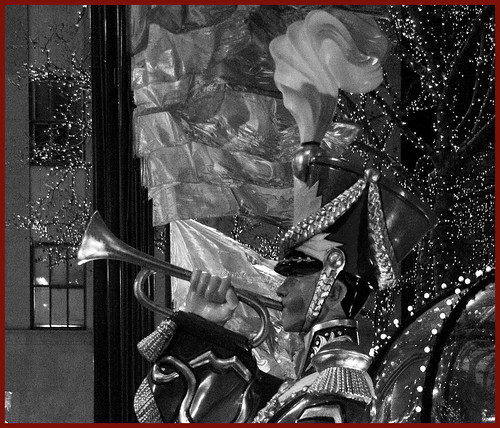Balancing aperture (f stop) and shutter speed can be tricky. Shutter speed stops the action (or conversely slows water down to make it look more velvety). Aperture determines how much of the scene is in focus-- narrow depth of field will have sharp focus on one plane of the scene with the rest blurry while a wide depth of field keeps everything in focus. F stop is represented as a reciprocal, so a high number (16) is 1/16th of the shutter open and provides everything in focus, while a low number (4.5) is 1/4th of the shutter open and therefore spreads the image of a wider area of the lens and makes only a small amount in focus. The more light available, the higher number f stop you can use and therefore have more options for choosing depth of field.
In this shot, "The Chase", I wanted to stop the action of this Ecuadoran boy reaching for the birds in the Plaza San Francisco. I also wanted to keep him, the birds, and the wall behind him in focus. Because it was fairly sunny, I had good light I chose depth of field f 13 and sacrificed a little bit of motion with a shutter speed of only 1/200th of a second. I stopped the boy's motion, but not the pigeons'.
Tuesday, February 9, 2010
The Chase
Monday, February 8, 2010
It's all about perspective...
One could view having ones vacation delayed and foreshortened by a day by snowmageddon or one could view this as an opportunity to visit Miami and wait there for the next available flight to Ecuador-- and live vicariously through all the elated Saints fans who are everywhere. This isn't the worst option and now we're finally on our way for the last leg of the trip.
This shot, Flight Delay, shows more about relative sizes and composition. One knows that the plane is bigger than a palm tree, but in this shot, the plane almost looks like a toy. Having the tree cover a portion of the plan tells the eye that the plane is behind the tree and at some distance in the background.
Infrared photo from a Nikon D70, f 10, 1/400 sec at 66 mm, ISO 200.
Monday, January 18, 2010
Using Wide Angle Lenses

This image, Rocketship to God, is a good example of the result of using a wide angle lens, i.e. a low number of mm. Your eye gives you a panoramic view of your scene, but the camera lens/sensor is only able to capture a small portion. If you zoom in , you get a close up view as if you were walking toward the object. Zooming out (as if you were getting father away) is more complicated optically. Because you are not truly getting father away, the lens compensates, but does this with distortion so that the items in the edge curve towards the center. To measure the amount of distortion, draw lines on each edge that should theoretically be parallel (rectilinear) and you will see that they converge (called barrel distortion).
In this photograph of the St. Louis Cathedral in Jackson Square, New Orleans, it appears that the spires have rotated inward. The large object combined with how close I was and by me shooting upward emphasizes the wide angle effect. While this can give a dramatic effect, it doesn't always work well with all scenes. Be especially wary of using wide angles when photographing someone's face. With most digital SLR cameras, using a focal length of anything lower than 42 mm will give some barrel distortion.
This photo was shot at 18mm at 1/320 sec, f18 with a Nikon D300 and Nikkor 18-200mm zoom lens.
Thursday, January 14, 2010
Composition - Choosing What to Put In and What to Leave Out



In this series of photos of the statue of Andrew Jackson in Jackson Square, New Orleans all of the photos are of the same thing, but are very different. Before clicking the shutter, the photographer needs to make a decision of what the photo is about. Is it to give a landscape view of the park or might someone be more interested in a close-up view of the statue. For someone who has never been to the Square, looking at the close-up view wouldn't be very satisfying in getting a picture of what the square looks like. For someone who really doesn't care about the square, but is an afficianado of "Old Hickory" (Andrew Jackson), the close-up view is going to be more interesting.
You can also see by these three shots, that even though they are of the same thing with the same lighting and camera, there is a very different feeling in each. Placing an object in relation to other objects can sometimes inform about relative size (as in the top view) or be distorting as in the middle view where the statue looks almost as large as the St. Louis Cathedral.
Even though you're shooting digital and don't have to worry about "wasting" film, take some time before you click the shutter. Walk around the area and view the scene from different angles to see where the best light is, assess the whole scene, and think about what story you want to tell.
The top photo, Jackson Square, 1/320, f14, 32 mm, and the middle is Place D'Armes,and bottom Old Hickory are 1/250, f13, 52 mm. All 3 photos shot with an infrared converted Nikon D70.
Monday, January 11, 2010
Compare and Contrast - Infrared HDR and Color HDR


Both of these shots were taken at about the same time of the same fountain in Bryant Park, New York City. Both are processed as HDR from one raw shot (see this blog). In the bottom shot, taken with an infrared converted Nikon D70, an infrared filter blocks out most light other than in the infrared spectrum, giving the surreal quality to the ice/water and providing greater contrast. In the top shot, the full spectrum of color is seen (minus infrared since most digital cameras are fairly insensitive to infrared light).
Both shots were processed in Photomatix and Photoshop CS4. The top shot is 1/80 sec, f 7.0 28 mm, ISO 400 and the bottom shot is 1/150 sec, f 4.0, 29 mm, ISO 400.
Sunday, January 3, 2010
January Morning
Sometimes it's the simple things in life. To the left of this shot is a busy street with cabs rushing by and to the right is a skating rink packed with skaters. In between, is a quiet walk among the mostly closed kiosks in Bryant Park in New York City-- kind of a serenity sandwich. And yes, it was as cold as it looks. It was in the teens with the wind chill and most of the water in a fountain nearby had turned to ice.
(1/250 sec, f 4.5, ISO 400, 52mm processed first in Photomatix with HDR generated from a single raw and then in Photoshop)
Saturday, January 2, 2010
Attention to Backgrounds


In these photos, having a busy background works out by giving the appearance that the showers of light are coming out of the trumpet (instead of from lights in a tree behind the figure). Sometimes, this doesn't work out so well when it can look like a statue is coming out of someones head or a tree branch out of someones ear. Framing a shot in photography should include not only what you want in your photo, but also what you want to exclude and how you want to line your main subject up in relation to background objects.
These photos are from Rockefeller Center in New York. The bottom, Hark the Herald was shot in color and converted to black and white to highlight the interplay between light and dark. The exposure settings were 1/80 sec, f 4.0, ISO 1600 at 38mm zoom. In the top one, Trumpet Shower of Light, color becomes more of the story. It was shot with similar settings to the first.




